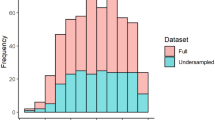Abstract
Neuroimaging-based infant age prediction is important for brain development analysis but often suffers insufficient data. To address this challenge, we introduce label distribution learning (LDL), a popular machine learning paradigm focusing on the small sample problem, for infant age prediction. As directly applying LDL yields dramatically increased number of day-to-day age labels and also extremely scarce data describing each label, we propose a new strategy, called granular label distribution (GLD). Particularly, by assembling the adjacent labels to granules and designing granular distributions, GLD makes each brain MRI contribute to not only its own age but also its neighboring ages at a granule scale, which effectively keeps the information augmentation superiority of LDL and reduces the number of labels. Furthermore, to extremely augment the information supplied by the small data, we propose a novel method named granular feature distribution (GFD). GFD leverages the variability of the brain images at the same age, thus significantly increases the learning effectiveness. Moreover, deep neural network is exploited to approximate the GLD. These strategies constitute a new model: deep granular feature-label distribution learning (DGFLDL). By taking 8 types of cortical morphometric features from structural MRI as predictors, the proposed DGFLDL is validated on infant age prediction using 384 brain MRI scans from 35 to 848 days after birth. Our proposed method, approaching the mean absolute error as 36.1 days, significantly outperforms the baseline methods. Besides, the permutation importance analysis of features based on our method reveals important biomarkers of infant brain development.
Access this chapter
Tax calculation will be finalised at checkout
Purchases are for personal use only
Similar content being viewed by others
References
Cole, J.H., Franke, K.: Predicting age using neuroimaging: innovative brain ageing biomarkers. Trends Neurosci. 40(12), 681–690 (2017)
Nenadic, I., Dietzek, M., Langbein, K., et al.: BrainAGE score indicates accelerated brain aging in schizophrenia, but not bipolar disorder. Psychiatry Res. Neuroimaging 266, 86–89 (2017)
Jason, S., Christian, H.: Differences between chronological and brain age are related to education and self- reported physical activity. Neurobiol. Aging 40, 138–144 (2016)
Toews, M., Wells, W.M., Zollei, L.: A feature-based developmental model of the infant brain in structural MRI. In: MICCAI 2012, vol. 15, no. 2, pp. 204–211(2012)
Gilmore, J.H., Kang, C., Evans, D.D., et al.: Prenatal and neonatal brain structure and white matter maturation in children at high risk for schizophrenia. Am. J. Psychiatry 167, 1083–1091 (2010)
Liem, F., Varoquaux, G., Kynast, J., et al.: Predicting brain-age from multimodal imaging data captures cognitive impairment. Neuroimage 148, 179–188 (2017)
Lewis, J.D., Evans, A.C., Tohka, J., Brain Development Cooperative Group: T1 white/gray contrast as a predictor of chronological age, and an index of cognitive performance. Neuroimage 173, 341–350 (2018)
Antipov, G., Baccouche, M., Berrani, S.A., Dugelay, J.L.: Effective training of convolutional neural networks for face-based gender and age prediction. Pattern Recogn. 72, 15–26 (2017)
Glasser, M., Coalson, T.S., Robinson, E.C., et al.: A multi-modal parcellation of human cerebral cortex. Nature 536, 171–178 (2016)
Geng, X.: Label distribution learning. IEEE Trans. Knowl. Data Eng. 28(7), 1734–1748 (2016)
Gao, B.B., Xing, C., Xie, C.W., Wu, J., Geng, X.: Deep label distribution learning with label ambiguity. IEEE Trans. Image Process. 26(6), 2825–2838 (2017)
Brittany, R.H., Martin, A.S., Wei, G., et al.: The UNC/UMN baby connectome project (BCP): an overview of the study design and protocol development. Neuroimage 185, 891–905 (2019)
Li, G., Wang, L., Yap, P.T., et al.: Computational neuroanatomy of baby brains: a review. Neuroimage 185, 906–925 (2019)
Li, G., Wang, L., Shi, F., et al.: Construction of 4D high-definition cortical surface atlases of infants: Methods and applications. Med. Image Anal. 25(1), 22–36 (2015)
Acknowledgments
This work was partially supported by NIH grants (MH107815, MH116225, and MH117943). This work also utilizes approaches developed by an NIH grant (1U01MH110274) and the efforts of the UNC/UMN Baby Connectome Project Consortium.
Author information
Authors and Affiliations
Consortia
Corresponding authors
Editor information
Editors and Affiliations
Rights and permissions
Copyright information
© 2019 Springer Nature Switzerland AG
About this paper
Cite this paper
Hu, D. et al. (2019). Deep Granular Feature-Label Distribution Learning for Neuroimaging-Based Infant Age Prediction. In: Shen, D., et al. Medical Image Computing and Computer Assisted Intervention – MICCAI 2019. MICCAI 2019. Lecture Notes in Computer Science(), vol 11767. Springer, Cham. https://doi.org/10.1007/978-3-030-32251-9_17
Download citation
DOI: https://doi.org/10.1007/978-3-030-32251-9_17
Published:
Publisher Name: Springer, Cham
Print ISBN: 978-3-030-32250-2
Online ISBN: 978-3-030-32251-9
eBook Packages: Computer ScienceComputer Science (R0)





